Training the Next Generation of Researchers in the Organ-on-Chip Field
Abstract
1. Introduction
- Which aspects of training are most important for the overall development of the OoC field?
- Which specific type of training in the OoC field should each stakeholder receive?
- What is the amount of training that each stakeholder should receive to achieve a certain level of experience in the OoC field?
2. Materials and Methods
2.1. Survey Description and Recruiting Method
- Q1. How would you define yourself as a professional? (a) Type of institution; (b) Job level; (c) Field of work; (d) Field of Graduate University education (Bachelor’s Degree); (e) Field of first Postgraduate University education (Master’s Degree); (f) Field of second Postgraduate University education (Doctorate Degree); (g) Main area of expertise
- Q2. Select the tissues/organs/systems/biological functions with which you are familiar and/or you work with?
- Q3. Select the microfabrication techniques for polymer-based microfluidic devices with which you are familiar and/or you work with?
- Q4. How important are the following aspects for the Organ-on-Chip field development?
- Q5. How important is it to provide specific training for each of the following stakeholders, to promote the Organ-on-Chip systems qualification, usability, uptake and/or long-term development?
- Q6. At which level do you consider that specific training is necessary to promote the Organ-on-Chip systems qualification, usability, uptake and/or long-term development?
- Q7–12. How important are the following elements to consider for training, for Scientists-as-developers /end users (Academia/Industry)/decision makers/technicians/clinicians regarding the improvement of Organ-on-Chip systems qualification, usability, uptake and/or long-term development?
- Q13. What is the most adequate complexity level of specific training for each of the following stakeholders, to promote Organ-on-Chip systems qualification, usability, uptake and/or long-term development?
- Q14. What is the most adequate amount of specific training for each of the following stakeholders, to promote Organ-on-Chip systems qualification, usability, uptake and/or long-term development?
- Q15. How important would it be to include the topic of Organ-on-Chip technologies as a seminar of course in the following broader field(s) of education?
2.2. Methods of Data Analysis
2.3. Subgrouping of the Respondents
- Work experience: PhD candidates 46% (69 respondents) versus senior scientists 51% (79 respondents)—respondents pursuing a doctoral degree compared to those of senior scientists (e.g., postdoctoral researchers, department heads, professors and upper management).
- Type of employer: Scientists in academia versus scientists in non-academic institutions (NAI) (regardless of whether they were PhD candidates or Senior scientists)—respondents from academic institutions compared to those working in industry, hospitals, small and medium-sized enterprises (SMEs, as defined by H2020) governmental and non-governmental organizations. As multiple answers were possible, whenever a respondent selected “academia”, he/she was excluded from the “NAI” group, resulting in 113 respondents in the “academia” group and 38 in the “NAI” group.
- Main area of expertise: “experts with biology expertise” (66 respondents that selected only choices from the biology-based area), “experts with engineering expertise” (43 respondents that selected only choices from the engineering-based area) or “experts with interdisciplinary expertise” (38 respondents that selected at least one biology-based and one engineering-based area of expertise).
2.4. Graphical Representation of the Data
3. Results
3.1. Professional Profile of the Respondents
3.2. Opinion of the Respondents on the State of Organ-on-Chip Development
3.3. Respondents Opinion on Specific Training Needs
4. Discussion
- Which aspects of training are the most important for the overall development of the OoC field?
- Definition of cell culture standards
- OoC usability
- Which specific type of training in the OoC field should each stakeholder receive?
- Scientists-as-end-users with a biology background should be trained in microfabrication and microfluidics principles.
- Scientists-as-developers should be trained in pharmacology/toxicology.
- What is the amount of training that each stakeholder should receive to achieve a certain level of experience in the OoC field?
- Scientists-as-developers should undergo specific post graduate training (1–2 years).
- Scientists-as-end-users should undergo specific practical training (up to 20 h) and seminars/courses integrated in a broader training.
Supplementary Materials
Author Contributions
Funding
Informed Consent Statement
Data Availability Statement
Acknowledgments
Conflicts of Interest
References
- Mastrangeli, M.; Partners, T.O.; Millet, S.; Raaij, J.V.D.E.-V. Organ-on-chip in development: Towards a roadmap for organs-on-chip. ALTEX 2019, 36, 650–668. [Google Scholar] [CrossRef] [PubMed]
- Rudmann, D.G. The Emergence of Microphysiological Systems (Organs-on-chips) as Paradigm-changing Tools for Toxicologic Pathology. Toxicol. Pathol. 2019, 47, 4–10. [Google Scholar] [CrossRef] [PubMed]
- van den Berg, A.; Mummery, C.L.; Passier, R.; Van Der Meer, A.D. Personalised organs-on-chips: Functional testing for precision medicine. Lab Chip 2019, 19, 198–205. [Google Scholar] [CrossRef] [PubMed]
- Franzen, N.; van Harten, W.H.; Retèl, V.P.; Loskill, P.; van den Eijnden-van Raaij, J.; Ijzerman, M. Impact of organ-on-a-chip technology on pharmaceutical R&D costs. Drug Discov. Today 2019, 24, 1720–1724. [Google Scholar] [CrossRef] [PubMed]
- Peck, R.W.; Hinojosa, C.D.; Hamilton, G.A. Organs-on-Chips in Clinical Pharmacology: Putting the Patient Into the Center of Treatment Selection and Drug Development. Clin. Pharmacol. Ther. 2020, 107, 181–185. [Google Scholar] [CrossRef] [PubMed]
- Herrmann, K. Beyond the 3Rs: Expanding the use of human-relevant replacement methods in biomedical research. ALTEX Altern. Anim. Exp. 2019, 36, 343–352. [Google Scholar] [CrossRef]
- Hippenstiel, S.; Thöne-Reineke, C.; Kurreck, J. Animal experiments: EU is pushing to find substitutes fast. Nature 2021, 600, 37. [Google Scholar] [CrossRef]
- Sohn, L.L.; Schwille, P.; Hierlemann, A.; Tay, S.; Samitier, J.; Fu, J.; Loskill, P. How Can Microfluidic and Microfabrication Approaches Make Experiments More Physiologically Relevant? Cell Syst. 2020, 11, 209–211. [Google Scholar] [CrossRef]
- OECD. Guidance Document on Good. In Vitro Method Practices (GIVIMP); OECD Series on Testing and Assessment; OECD: No. 286; OECD Publishing: Paris, France, 2018. [Google Scholar] [CrossRef]
- Mastrangeli, M.; Millet, S.; Mummery, C.; Loskill, P.; Braeken, D.; Eberle, W.; Cipriano, M.; Fernandez, L.; Graef, M.; Gidrol, X.; et al. Building Blocks for a European Organ-on-Chip Roadmap. ALTEX Altern. Anim. Exp. 2019, 36, 481–492. [Google Scholar] [CrossRef]
- Marx, U.; Akabane, T.; Andersson, T.B.; Baker, E.; Beilmann, M.; Beken, S.; Brendler-Schwaab, S.; Cirit, M.; David, R.; Dehne, E.-M.; et al. Biology-inspired microphysiological systems to advance medicines for patient benefit and animal welfare. ALTEX 2020, 37, 365–394. [Google Scholar] [CrossRef]
- Baran, S.W.; Brown, P.C.; Baudy, A.R.; Fitzpatrick, S.C.; Frantz, C.; Fullerton, A.; Gan, J.; Hardwick, R.N.; Hillgren, K.M.; Kopec, A.K.; et al. Perspectives on the evaluation and adoption of complex in vitro models in drug development: Workshop with the FDA and the pharmaceutical industry (IQ MPS Affiliate). ALTEX Altern. Anim. Exp. 2022, 39, 297–314. [Google Scholar] [CrossRef]
- Allwardt, V.; Ainscough, A.J.; Viswanathan, P.; Sherrod, S.D.; McLean, J.A.; Haddrick, M.; Pensabene, V. Translational Roadmap for the Organs-on-a-Chip Industry toward Broad Adoption. Bioengineering 2020, 7, 112. [Google Scholar] [CrossRef] [PubMed]
- Mastrangeli, M.; Raaij, J.V.D.E.-V. Organs-on-chip: The way forward. Stem Cell Rep. 2021, 16, 2037–2043. [Google Scholar] [CrossRef] [PubMed]
- Piergiovanni, M.; Leite, S.B.; Corvi, R.; Whelan, M. Standardisation needs for organ on chip devices. Lab Chip 2021, 21, 2857–2868. [Google Scholar] [CrossRef] [PubMed]
- Singer, A.; Montgomery, G.; Schmoll, S. How to foster the formation of STEM identity: Studying diversity in an authentic learning environment. Int. J. STEM Educ. 2020, 7, 57. [Google Scholar] [CrossRef]
- Stella, M.; de Nigris, S.; Aloric, A.; Siew, C.S.Q. Forma mentis networks quantify crucial differences in STEM perception between students and experts. PLoS ONE 2019, 14, e0222870. [Google Scholar] [CrossRef]
- Takeuchi, M.A.; Sengupta, P.; Shanahan, M.-C.; Adams, J.D.; Hachem, M. Transdisciplinarity in STEM education: A critical review. Stud. Sci. Educ. 2020, 56, 213–253. [Google Scholar] [CrossRef]
- Choi, B.C.K.; Pak, A.W.P. Multidisciplinarity, interdisciplinarity and transdisciplinarity in health research, services, education and policy: 1. Definitions, objectives, and evidence of effectiveness. Clin. Investig. Med. 2007, 29, 351–364. [Google Scholar]
- Federer, L.M.; Lu, Y.-L.; Joubert, D.J. Data literacy training needs of biomedical researchers. J. Med. Libr. Assoc. 2016, 104, 52–57. [Google Scholar] [CrossRef]
- Weber, R.J.M.; Winder, C.L.; Larcombe, L.D.; Dunn, W.B.; Viant, M.R. Training needs in metabolomics. Metabolomics 2015, 11, 784–786. [Google Scholar] [CrossRef]
- Barratt, H.; Fulop, N.J. Building capacity to use and undertake research in health organisations: A survey of training needs and priorities among staff. BMJ Open 2016, 6, e012557. [Google Scholar] [CrossRef] [PubMed]
- Carracedo, F.S.; Soler, A.; Martín, C.; López, D.; Ageno, A.; Cabré, J.; Garcia, J.; Aranda, J.; Gibert, K. Competency Maps: An Effective Model to Integrate Professional Competencies Across a STEM Curriculum. J. Sci. Educ. Technol. 2018, 27, 448–468. [Google Scholar] [CrossRef]
- Batista Leite, S.; Cipriano, M.; Capri, D.; Coecke, S.; Holloway, M.; Corvi, R.; Worth, A.; Barroso, J.; Whelan, M. Establishing the Scientific Validity of Complex In Vitro Models: Results of a EURL ECVAM Survey; EUR 30556 EN; Publications Office of the European Union: Luxembourg, 2021; ISBN 978-92-76-28410-9. [Google Scholar]
- Mastrangeli, M.; Aydogmus, H.; Dostanic, M.; Motreuil-Ragot, P.; Revyn, N.; De Wagenaar, B.; Dekker, R.; Sarro, P.M. Microelectromechanical Organs-on-Chip. In Proceedings of the 2021 21st International Conference on Solid-State Sensors, Actuators and Microsystems (Transducers), Orlando, FL, USA, 20–24 June 2021; pp. 102–107. [Google Scholar]
- Loskill, P.; Hardwick, R.N.; Roth, A. Challenging the pipeline. Stem Cell Rep. 2021, 16, 2033–2037. [Google Scholar] [CrossRef] [PubMed]
- Maass, C.; Stokes, C.L.; Griffith, L.G.; Cirit, M. Multi-functional scaling methodology for translational pharmacokinetic and pharmacodynamic applications using integrated microphysiological systems (MPS). Integr. Biol. 2017, 9, 290–302. [Google Scholar] [CrossRef]
- Cirit, M.; Stokes, C.L. Maximizing the Impact of Microphysiological Systems with: In Vitro—In Vivo Translation. Lab Chip 2018, 18, 1831–1837. [Google Scholar] [CrossRef]
- Budwig, N.; Alexander, A.J. A Transdisciplinary Approach to Student Learning and Development in University Settings. Front. Psychol. 2020, 11, 576250. [Google Scholar] [CrossRef]
- Miranda, J.; Navarrete, C.; Noguez, J.; Molina-Espinosa, J.-M.; Ramírez-Montoya, M.-S.; Navarro-Tuch, S.A.; Bustamante-Bello, M.-R.; Rosas-Fernández, J.-B.; Molina, A. The core components of education 4.0 in higher education: Three case studies in engineering education. Comput. Electr. Eng. 2021, 93, 107278. [Google Scholar] [CrossRef]
- Yang, L.; Albats, E.; Etzkowitz, H. Interdisciplinary organization as a basic academic unit? Ind. High. Educ. 2021, 35, 173–187. [Google Scholar] [CrossRef]
- Velez, A.-L.; Hall, R.P.; Lewis, S.N. Designing transdisciplinarity: Exploring institutional drivers and barriers to collaborative transdisciplinary teaching. J. Public Aff. Educ. 2022, 28, 138–155. [Google Scholar] [CrossRef]
- Esch, E.W.; Bahinski, A.; Huh, D. Organs-on-chips at the frontiers of drug discovery. Nat. Rev. Drug Discov. 2015, 14, 248–260. [Google Scholar] [CrossRef]
- Holley, T.; Bowe, G.; Campia, I.; Belz, S.; Berggren, E.; Janusch Roi, A.; Wittwehr, C.; Whelan, M. Accelerating Progress in the Replacement, Reduction and Refinement of Animal Testing through Better Knowledge Sharing; UR 28234 EN; Publications Office of the European Union: Luxembourg, 2016. [Google Scholar]
- Rogal, J.; Schlünder, K.; Loskill, P. Developer’s Guide to an Organ-on-Chip Model. ACS Biomater. Sci. Eng. 2022, 8, 4643–4647. [Google Scholar] [CrossRef] [PubMed]
- Fuchs, S.; Johansson, S.; Tjell, A.; Werr, G.; Mayr, T.; Tenje, M. In-Line Analysis of Organ-on-Chip Systems with Sensors: Integration, Fabrication, Challenges, and Potential. ACS Biomater. Sci. Eng. 2021, 7, 2926–2948. [Google Scholar] [CrossRef]
- Zhou, L.; Liu, L.; Chang, M.A.; Ma, C.; Chen, W.; Chen, P. Spatiotemporal dissection of tumor microenvironment via in-situ sensing and monitoring in tumor-on-a-chip. Biosens. Bioelectron. 2023, 225, 115064. [Google Scholar] [CrossRef]
- Beebe, D.J.; Ingber, D.E.; Toonder, J.D. Organs on Chips 2013. Lab Chip 2013, 13, 3447–3448. [Google Scholar] [CrossRef] [PubMed]
- Ramadan, Q.; Zourob, M. Organ-on-a-chip engineering: Toward bridging the gap between lab and industry. Biomicrofluidics 2020, 14, 041501. [Google Scholar] [CrossRef] [PubMed]
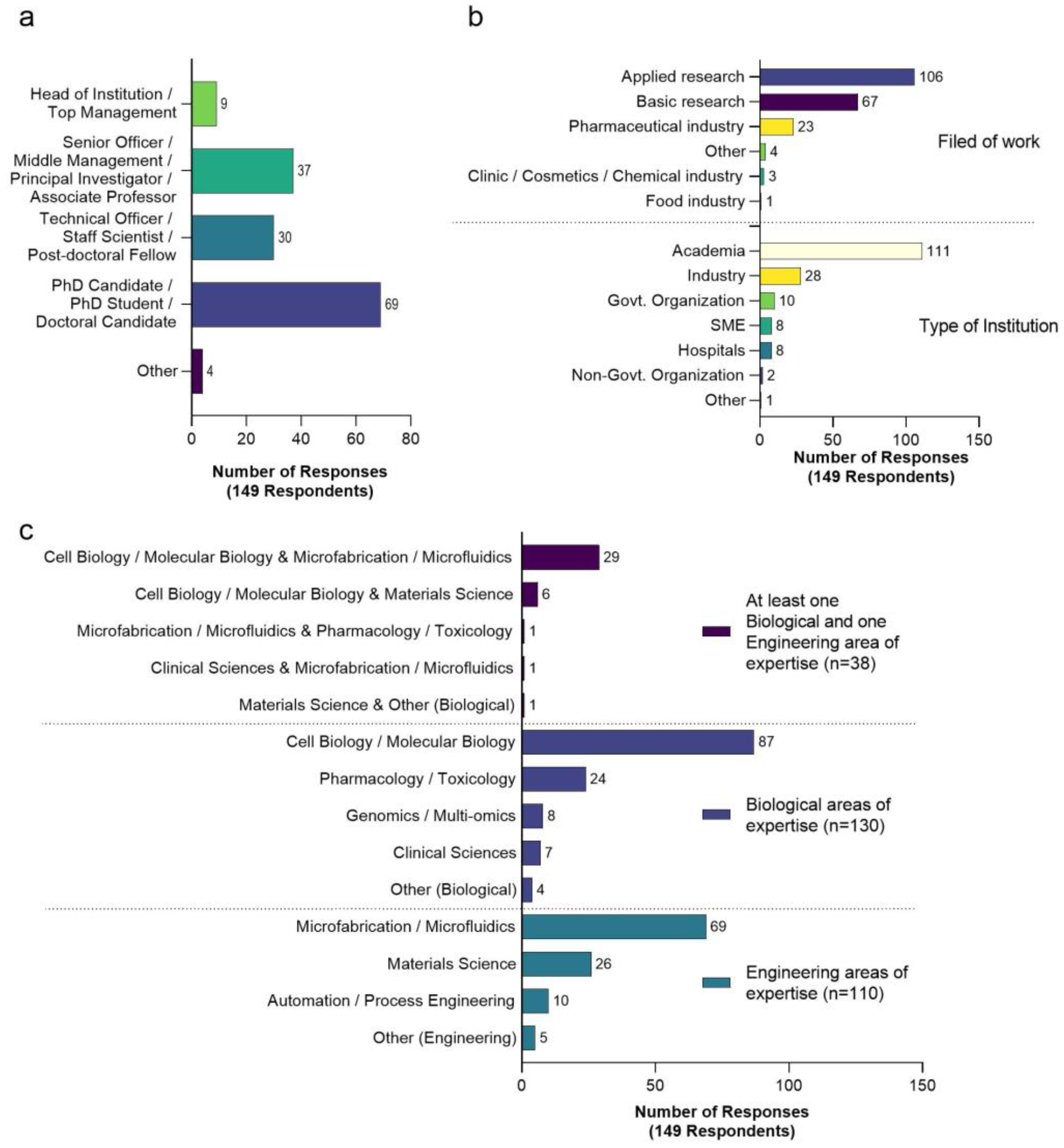
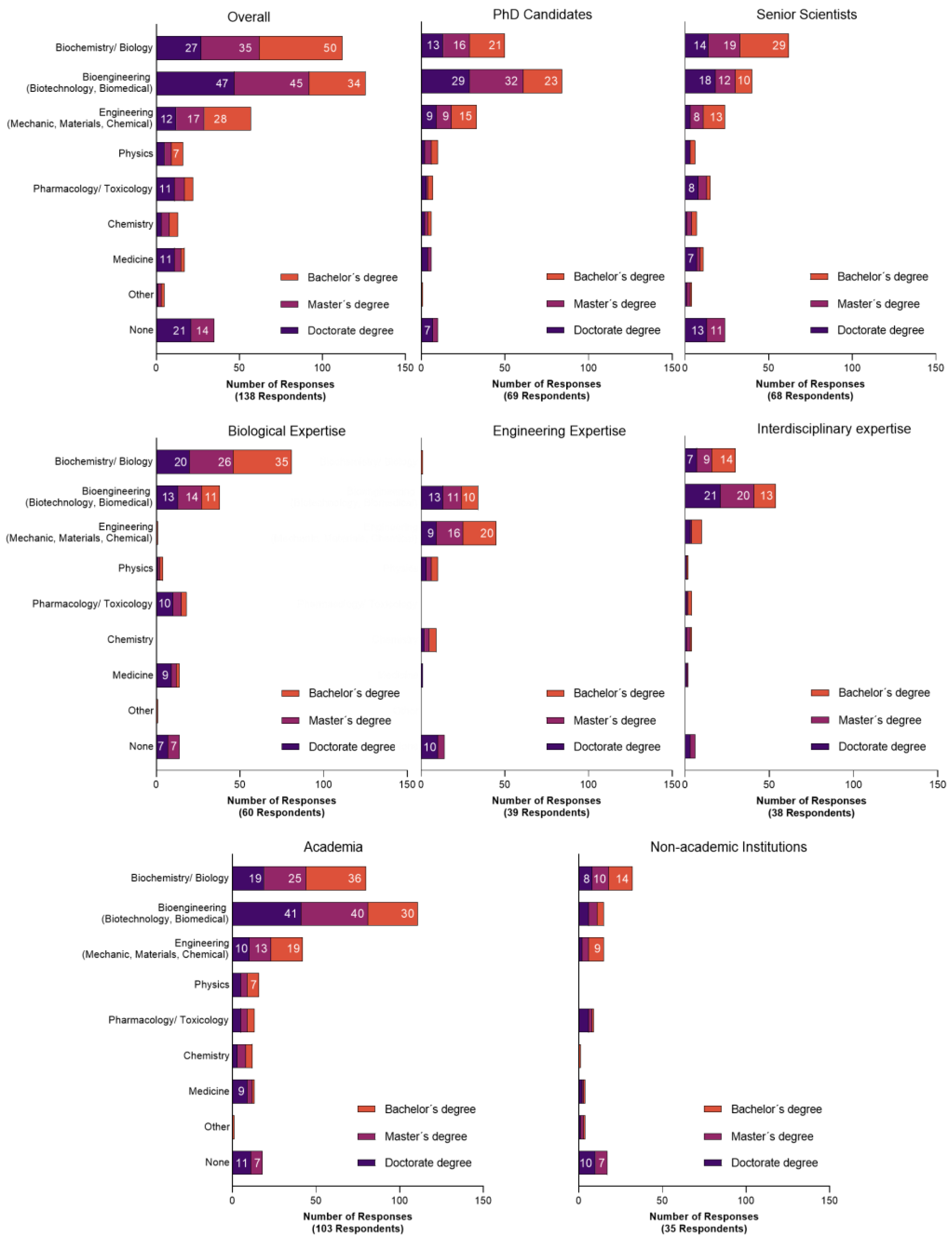
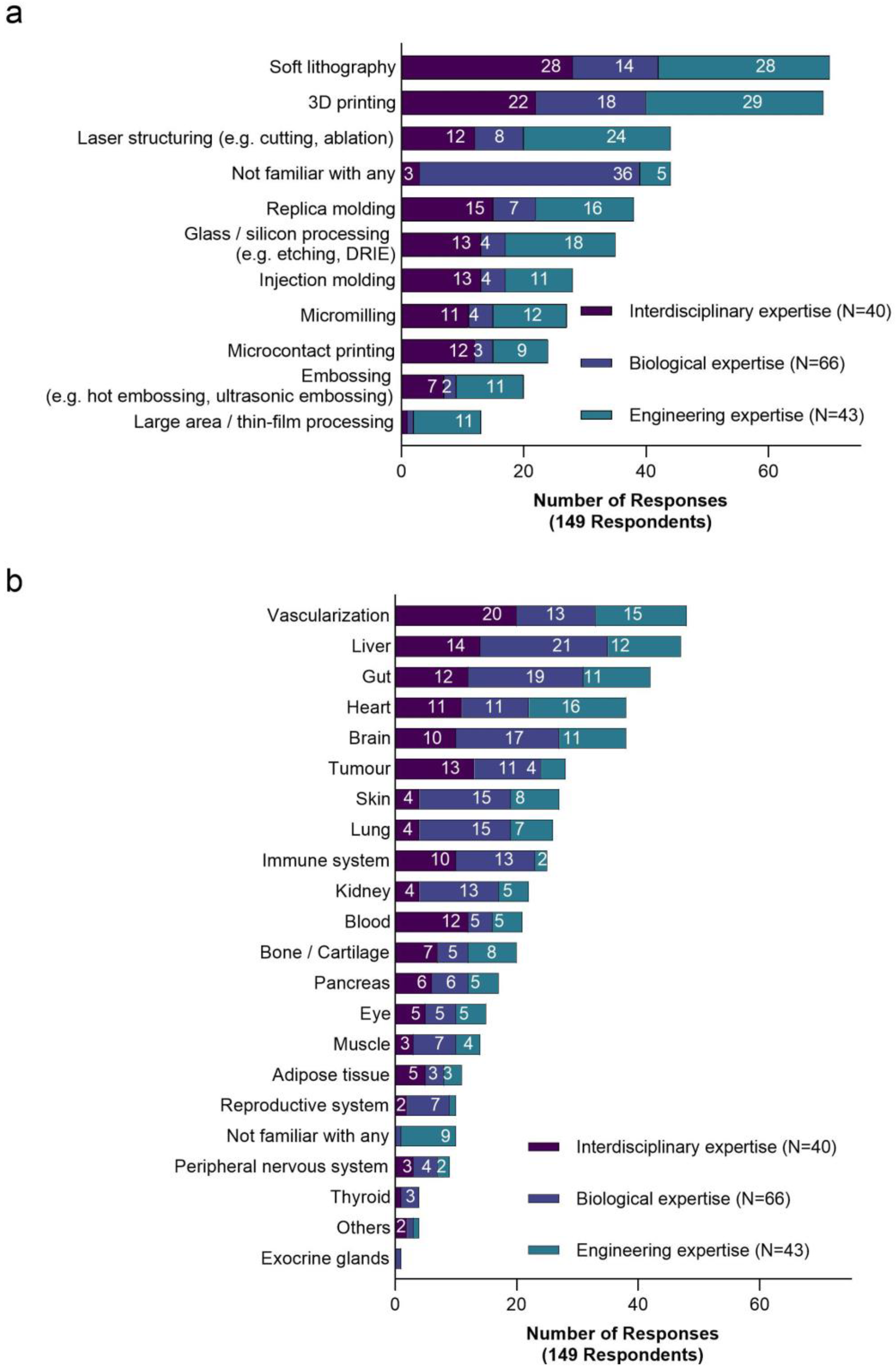
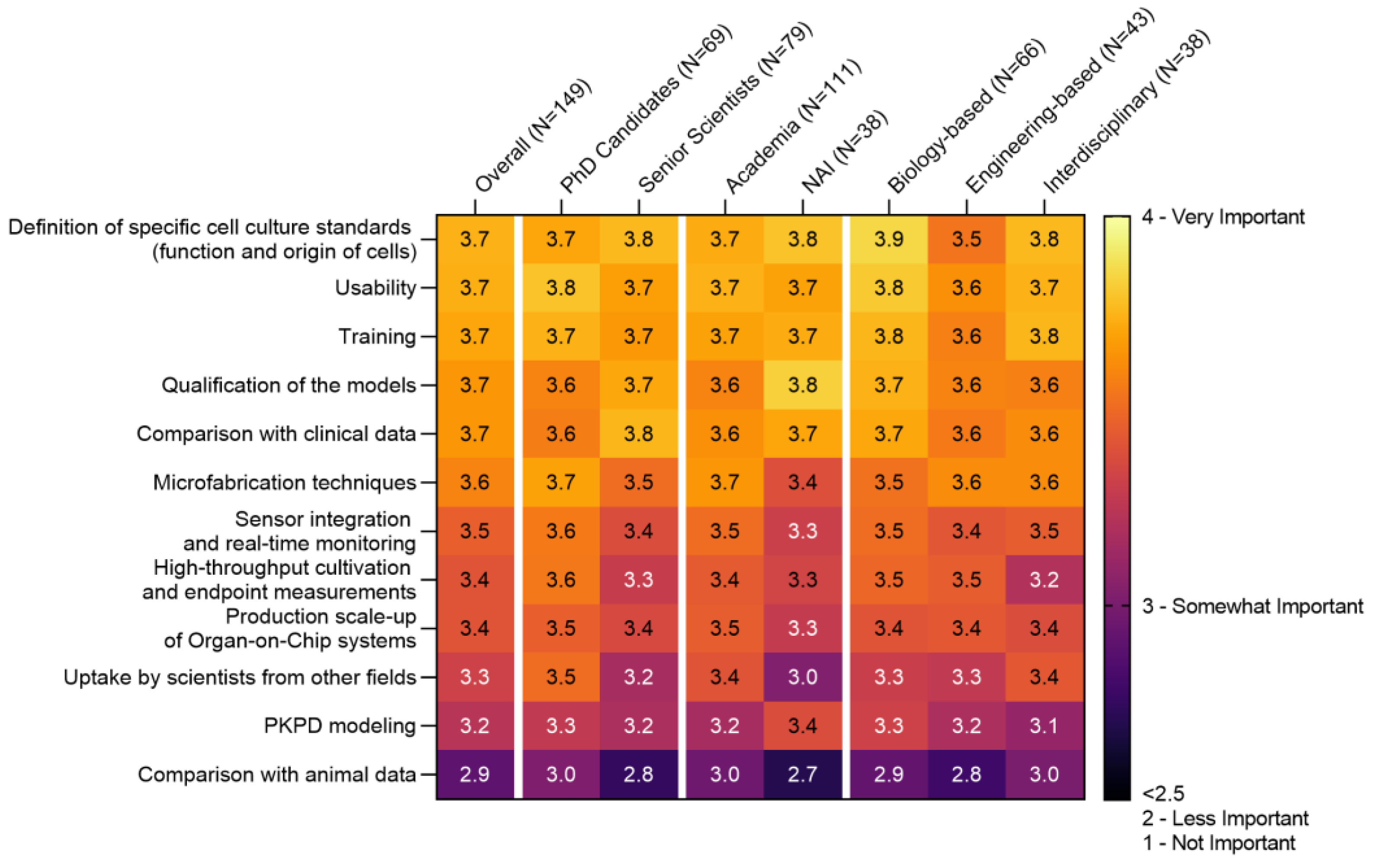
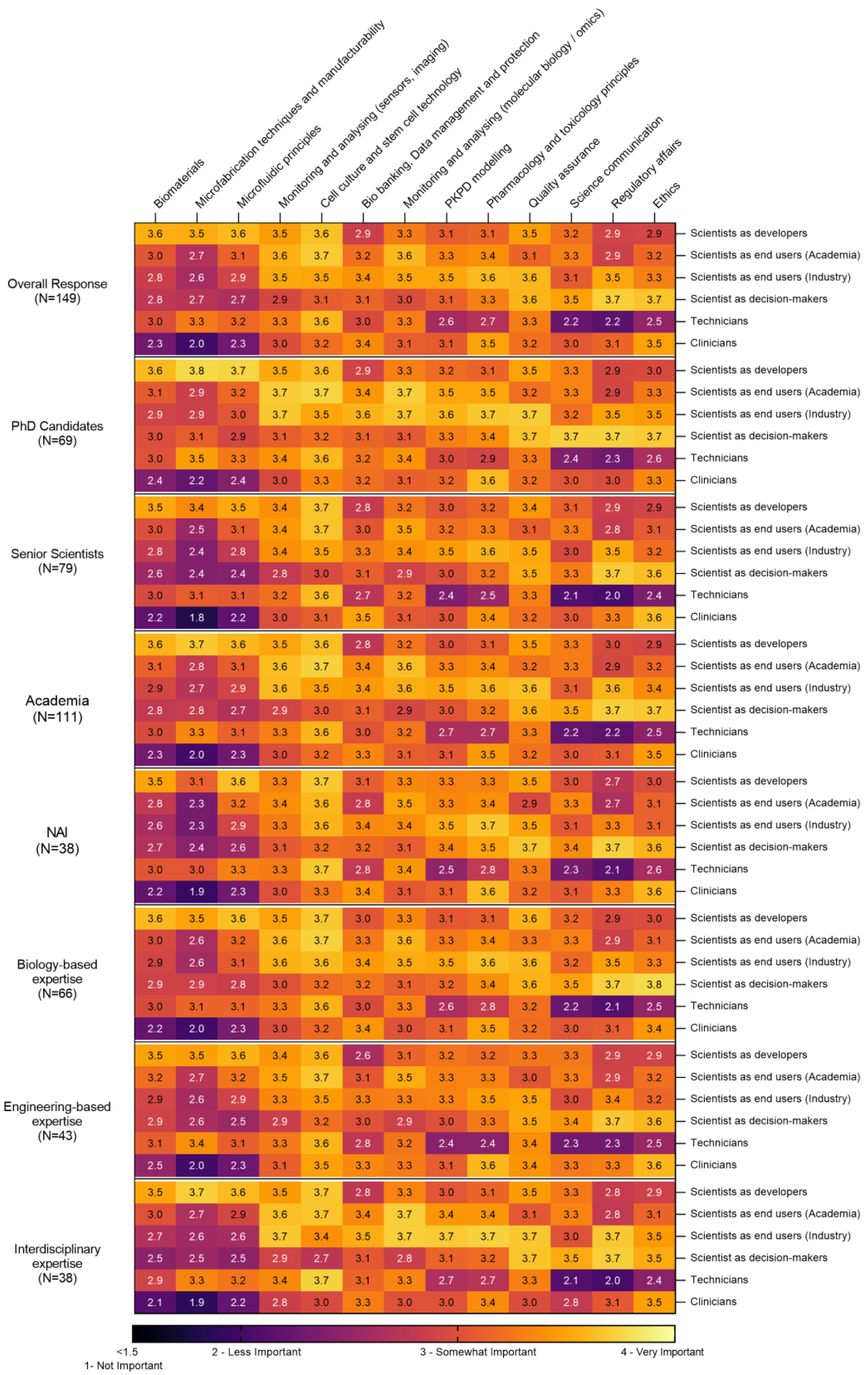
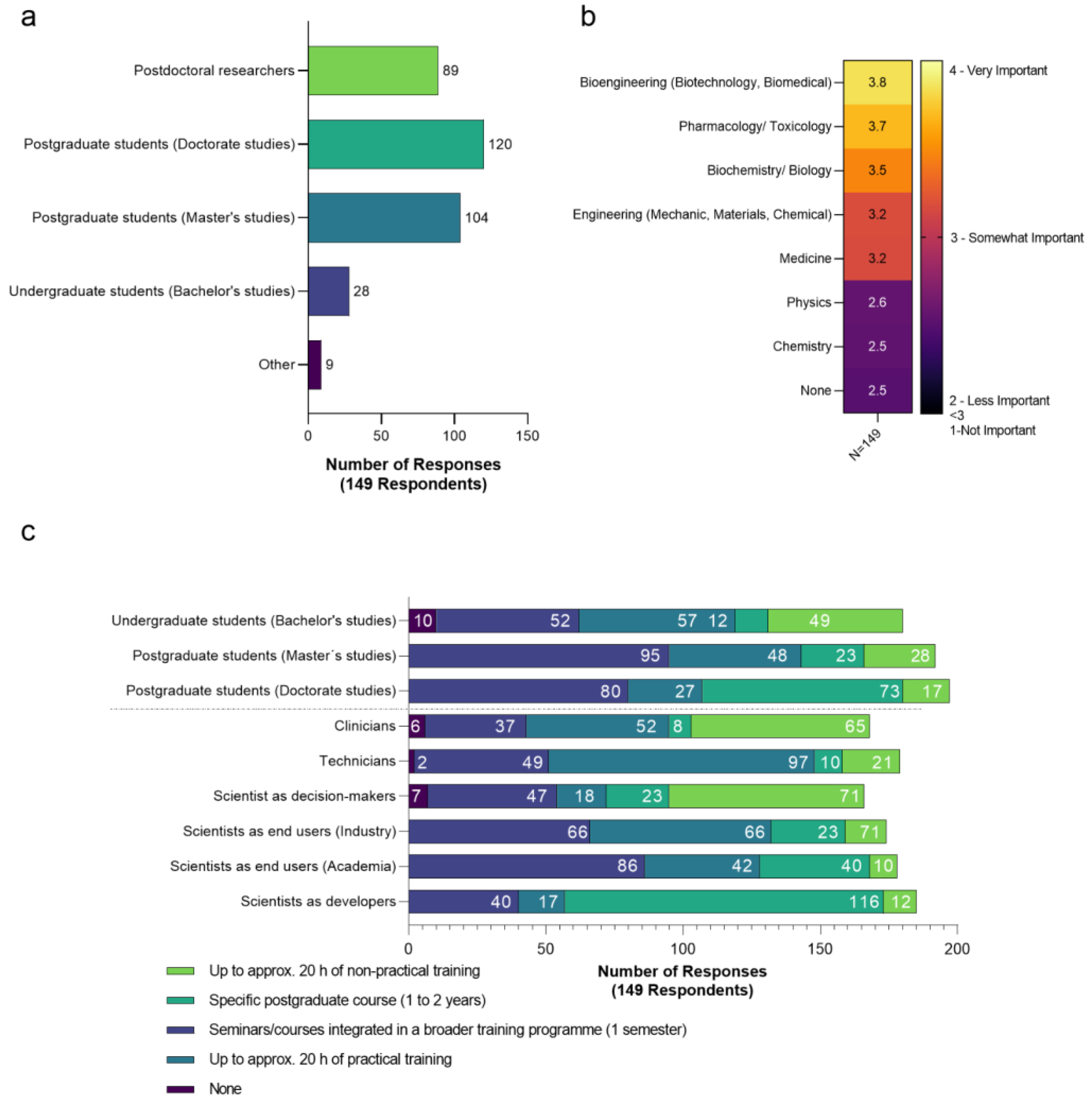
Disclaimer/Publisher’s Note: The statements, opinions and data contained in all publications are solely those of the individual author(s) and contributor(s) and not of MDPI and/or the editor(s). MDPI and/or the editor(s) disclaim responsibility for any injury to people or property resulting from any ideas, methods, instructions or products referred to in the content. |
© 2023 by the authors. Licensee MDPI, Basel, Switzerland. This article is an open access article distributed under the terms and conditions of the Creative Commons Attribution (CC BY) license (https://creativecommons.org/licenses/by/4.0/).
Share and Cite
Moruzzi, A.; Shroff, T.; Keller, S.; Loskill, P.; Cipriano, M. Training the Next Generation of Researchers in the Organ-on-Chip Field. Educ. Sci. 2023, 13, 144. https://doi.org/10.3390/educsci13020144
Moruzzi A, Shroff T, Keller S, Loskill P, Cipriano M. Training the Next Generation of Researchers in the Organ-on-Chip Field. Education Sciences. 2023; 13(2):144. https://doi.org/10.3390/educsci13020144
Chicago/Turabian StyleMoruzzi, Alessia, Tanvi Shroff, Silke Keller, Peter Loskill, and Madalena Cipriano. 2023. "Training the Next Generation of Researchers in the Organ-on-Chip Field" Education Sciences 13, no. 2: 144. https://doi.org/10.3390/educsci13020144
APA StyleMoruzzi, A., Shroff, T., Keller, S., Loskill, P., & Cipriano, M. (2023). Training the Next Generation of Researchers in the Organ-on-Chip Field. Education Sciences, 13(2), 144. https://doi.org/10.3390/educsci13020144







